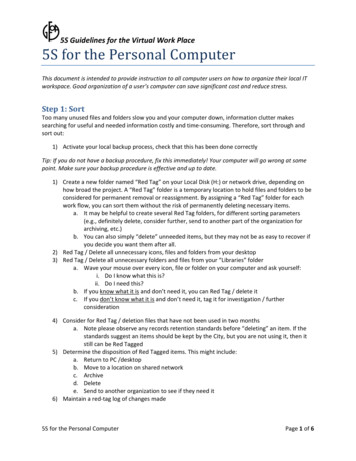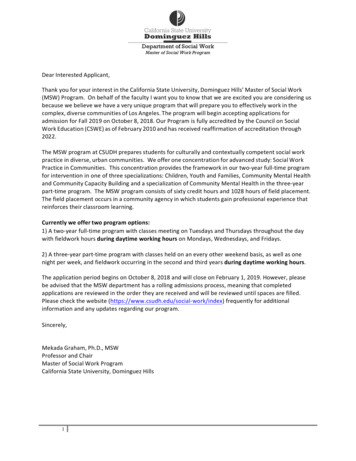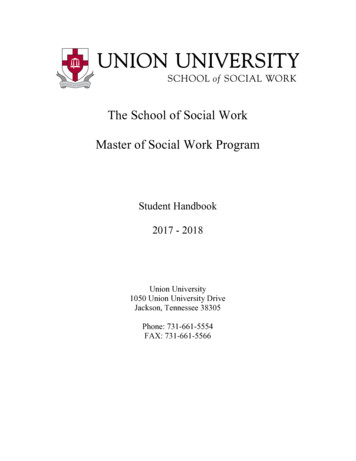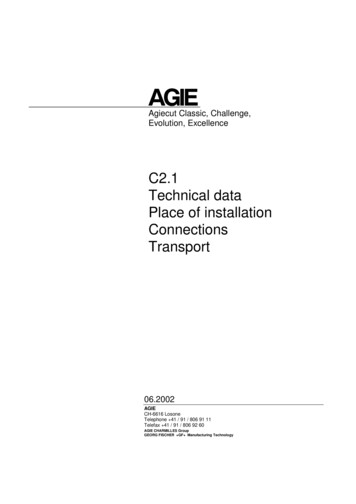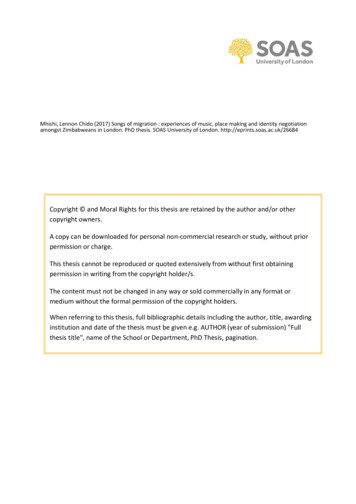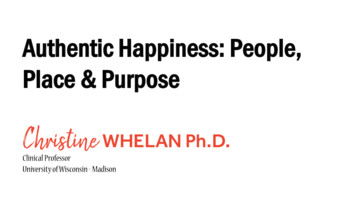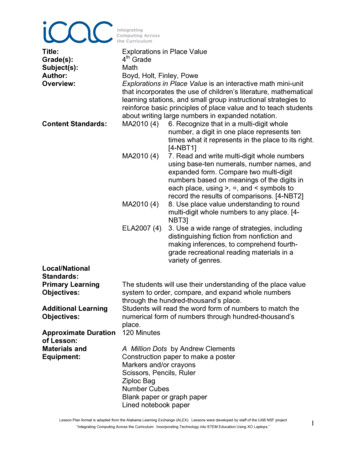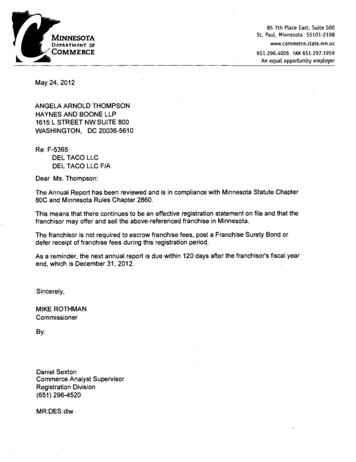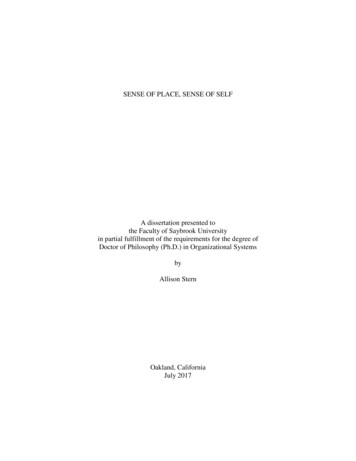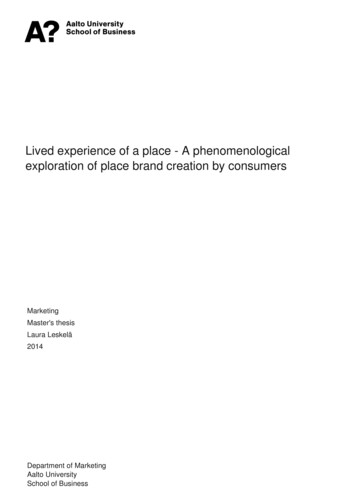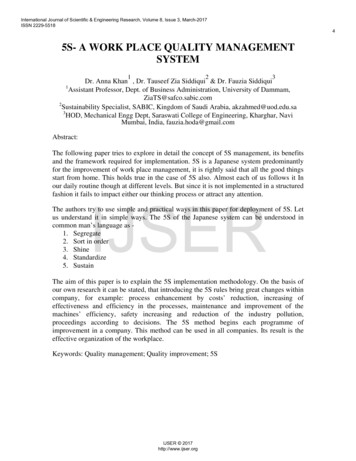
Transcription
International Journal of Scientific & Engineering Research, Volume 8, Issue 3, March-2017ISSN 2229-551845S- A WORK PLACE QUALITY MANAGEMENTSYSTEM123Dr. Anna Khan , Dr. Tauseef Zia Siddiqui & Dr. Fauzia Siddiqui1Assistant Professor, Dept. of Business Administration, University of Dammam,ZiaTS@safco.sabic.com2Sustainability Specialist, SABIC, Kingdom of Saudi Arabia, akzahmed@uod.edu.sa3HOD, Mechanical Engg Dept, Saraswati College of Engineering, Kharghar, NaviMumbai, India, fauzia.hoda@gmail.comAbstract:The following paper tries to explore in detail the concept of 5S management, its benefitsand the framework required for implementation. 5S is a Japanese system predominantlyfor the improvement of work place management, it is rightly said that all the good thingsstart from home. This holds true in the case of 5S also. Almost each of us follows it Inour daily routine though at different levels. But since it is not implemented in a structuredfashion it fails to impact either our thinking process or attract any attention.IJSERThe authors try to use simple and practical ways in this paper for deployment of 5S. Letus understand it in simple ways. The 5S of the Japanese system can be understood incommon man’s language as 1. Segregate2. Sort in order3. Shine4. Standardize5. SustainThe aim of this paper is to explain the 5S implementation methodology. On the basis ofour own research it can be stated, that introducing the 5S rules bring great changes withincompany, for example: process enhancement by costs’ reduction, increasing ofeffectiveness and efficiency in the processes, maintenance and improvement of themachines’ efficiency, safety increasing and reduction of the industry pollution,proceedings according to decisions. The 5S method begins each programme ofimprovement in a company. This method can be used in all companies. Its result is theeffective organization of the workplace.Keywords: Quality management; Quality improvement; 5SIJSER 2017http://www.ijser.org
International Journal of Scientific & Engineering Research, Volume 8, Issue 3, March-2017ISSN 2229-55181.0Introduction5S is the name of a workplace organization method that uses a list of five Japanesewords: seiri, seiton, seiso, seiketsu, and shitsuke. Any manufacturing facilities have optedto follow the path towards a “5S” workplace organizational and housekeepingmethodology as part of continuous improvement or lean manufacturing processes.5S is a structured program to achieve total organization, cleanliness and standardizationin work place because a well-organized work place results in safer, more efficient andmore productive operation. It boosts the morale of workers, promoting the sense of prideand ownership of responsibilities.2.0Literature Review5S was first introduced in Japan and stands for five words starting with letter “S” andthese stand for:1. Seiri – meaning sorting –Tidiness- Putting things in order. This means sorting andorganizing the items as critical, vital, frequently used items, useless, or items thatare not need as of now. Unwanted items can be salvaged. Critical items should bekept for use nearby and items that are not be used in near future, should be storedin some place. For this step, the value of the item should be decided based onutility and not cost. As a result of this step, the search time is reduced.IJSER2. Seiton-meaning setting/Straighten - Orderliness-Proper arrangement. Here theconcept is “A Place for Everything and Everything in its place”. The items shouldbe placed back after usage at the same place. To identify items easily, name platesand colored tags has to be used. Vertical racks can be used for this purpose, andheavy items occupy the bottom position in the racks.3. Seiso- meaning Shining – Clean /Cleanliness. This involves cleaning the workplace free of burrs, grease, oil, waste, scrap etc. No loosely hanging wires or oilleakage from machines. Here cleaning is in the form of inspection. When we arecleaning, we are inspecting simultaneously, if something is unnecessary we arediscarding those things (under 1S) and if throughout cleaning we have seen thatany item is not kept in correct place, we put them in its place (doing 2S). Hencewhenever we are doing ‘3S’ means we are doing ‘1S’ and ‘2S’ simultaneously. Inaddition we check for the health of the machine, lubrication, electricalconnections etc., Clean your work place completely so that there should not beany dust on the floor, walls, windows, desk, table, machinery etc. Cleaning shouldbe done in Macro first and then in micro level or individual items.4. Seiketsu – meaning Standardization – Purity – Perpetual Cleaning.5. Shitsuke – Meaning – sustain –commitment to above four Ss. This meanswhatever system we are having or developed by us under ‘4S’ to be followed inIJSER 2017http://www.ijser.org5
International Journal of Scientific & Engineering Research, Volume 8, Issue 3, March-2017ISSN 2229-5518such a way so that, standard practices become a part of our life. This will benefitto keep high level of work place organization at all the time.3.0Approach and MethodologyAs per Iwao Kabayashi who introduced this concept of 5S these simple steps leads to bestworking environment. 5S is the silent informer of a company’s attitude to quality, work& people management. The easiest way to determine the attitude towards improvementactivities is simply to walk around the plant and observe the house – keeping practice. Itoften tells us more about the company than any financial statement. One can judge thelevel of improvement activities from the way tools are stored, swath and chips frommachines handled, work table organized, inspection points indicated, factory floor swept,machines cleaned, canteen and toilet condition etc. The practices reflect themanagement’s general attitude towards work and employees.We should understand the linkage between the level of Five S and the amount ofdefective products produced, the number of machine breakdown, inventory level and soon. Therefore Five S should be among the first steps management should take forimproving the company’s quality status. Five S are an important aspect of team - work. Ifwe don’t do Five S, we cannot do any other work efficiently. Five S starts with eachindividual practicing it. When we go to work we notice many things, which are not inorder, but we overlook them and turn a blind eye to them. Unfortunately we do notrealize that many of our problems will disappear if we pay attention to Five S. We shouldnot think that Five S actions are for others to implement. Our action speaks louder thanwords. 5S is a system to reduce waste and optimize productivity through maintaining anorderly workplace and using visual cues to achieve more consistent operational results.5S programs are usually implemented by small teams working together to get materialscloser to operations, right at workers’ fingertips and organized and labeled to facilitateoperations with the smallest amount of wasted time and materials.IJSERThe 5S system is a good starting point for all improvement efforts aiming to drive outwaste from the manufacturing process, and ultimately improve a company’s bottom lineby improving products and services, and lowering costs. Many companies are seeking tomaking operations more efficient, and the concept is especially attractive to oldermanufacturing facilities looking to improve the bottom line by reducing their costs.3.1Implementation MethodologyImplementing the 5S method means cleaning up and organizing the workplace in itsexisting configuration. It is typically the first lean method that organizations implement.This lean method encourages workers to improve their working conditions and helpsthem to learn to reduce waste, unplanned downtime, and in-process inventory. A typical5S implementation would result in significant reductions in the square footage of spaceneeded for existing operations. It also would result in the organization of tools andIJSER 2017http://www.ijser.org6
International Journal of Scientific & Engineering Research, Volume 8, Issue 3, March-2017ISSN 2229-5518materials into labeled and color coded storage locations, as well as “kits” that contain justwhat is needed to perform a task.The 5S methodology is a simple and universal approach that works in companies all overthe world. It is essentially a support to such other manufacturing improvements as just in-time (JIT) production, cellular manufacturing, total quality management (TQM), or sixsigma initiatives, and is also a great contributor to making the workplace a better place tospend time.METHODOLOGY FOR OFFICE 5S IMPLEMENTATIONPlanning in 5W & 1H Framework{Which area, Why organize, Where (sub zones), When, Who}How will we do 5S?IJSERSEIRI [Sort and discard unnecessary things]Steps:A)B)C)D)Examine all articles which is needed & which is not.Useless articles should be separated from useful ones.Categorize wanted items based on their frequency of usage.Keep the regularly used items in a handy place where as keepthe rarely used items in a distant place.E) Get rid of unwanted items.F) Do not place things in the way.SEITON [Arranging of items for use so that our working is smooth.]Steps:A) The clear planning of passages indicating entry and exit is of primeimportance.B) Prepare storage areas for storing the items.C) Decide the place for everything in a manner that the thing canbe reached without any strain or extra effort.D) Put a tag/sign/label for each location of an item/person.E) A proper indication needs to be made for items that are needed fortemporary use.F) Color-coding should be used for quick identification. Proper indicationis required for items that are out of stock, items in use and items thatare lost and retrieved.G) The caution boards, messages and instructions should be writtenand displayed in a manner that is easy for people to read and follow.IJSER 2017http://www.ijser.org7
International Journal of Scientific & Engineering Research, Volume 8, Issue 3, March-2017ISSN 2229-5518H) It should be ensured that there is a regular and frequent inspection ofthe entire scheme of things.I) Arrange articles according to their shapes and weights in differentsections of the cupboard.J) The passages are not to be obstructed and create problems formovement of material and people.SEISO [Cleaning all places]Steps:A) Divide the work area into distinct zones for purpose of cleaning.B) It is not the workplace alone, but the whole surrounding should bekept clean and tidy.C) Allocate individual responsibility for each zone by clearly spellingout what needs to be done.D) Make everyone study the current cleaning situation objectively inorder to clearly ascertain what needs to be cleaned and what should bethe order of cleaning.E) Each zone in charge should provide training to his subordinates on thecleaning system.F) Make cleaning work a personal responsibility of the individuals byspecifying it clearly. This also ensures elimination of work avoidance.G) If required, revise the way of cleaning and the tools used so thatthose hard to clean places will be easy to clean.H) Decide on the safety precautions etc.to keep the things the waywe want it to be.I) Regular inspection should be done to evaluate the progress.The problems revealed should be analyzed and solved.IJSERSEIKETSU [Systemizing the above practices]Steps:A) The first step is to systemize the practices of Seiri, Seiton, Seiso takingthe opinion of the entire group.B) The standard practices that evolve out of the discussions are to beregistered and circulated widely.C) Following should be clearly depicted in display charts:a. Danger Alerts.b. Indication of where things are to be kept.c. Equipment designation / Instructions.d. Caution and Standard Operating Procedures.e. Preventive Maintenance Display.f. Instructions.D) Display charts properly in order to help people avoid errors. Thecharts should be visible not only to the workers within the unit, butalso to anyone passing through.IJSER 2017http://www.ijser.org8
International Journal of Scientific & Engineering Research, Volume 8, Issue 3, March-2017ISSN 2229-5518E) Messages should be as clear as possible such that they can beseen from a distance.F) Prepare manual to standardize the visual management for properfollow up.G) Visual management is essential because everybody will know whenthere is a problem and would hence initiate proper actions.SHITSUKE [Strict adherence to the system – Discipline]Steps:A) Pay attention to the minutest aspect of a process and ensure that theentire functional requirement for 5S becomes a habit with everyone.B) Make the training program simple and interesting.C) Clearly allocate jobs in a manner that ensures everyone is willingto work on its implementation.D) All types of instructions whether oral or written should be clear andthere should be a continuous feedback on the understanding andcompliance of these instructions.E) Prepare a checklist along with an action plan. Ensure propermonitoring of the action plan4.0IJSERRecommendations for 5S ImplementationSuccessful implementation of 5S requires lot of patience and attention to details. Afterunderstanding the implementation methodology, the organizations should carry acomprehensive campaign for building awareness on 5S Concepts along with formation ofZones and committee to oversee the progress.Step by step implementation phase is explained below:PHASE I – Awareness programme and planning:1. Top management exposure programme.2. To integrate ‘5-S’ in management objectives.3. Formation of ‘5-S’ steering committee. This committee will meet once in a monthfor periodic and regular review of implementation status. Committee will alsodiscuss for future action plan.4. Nomination of coordinating agency and Chief coordinator.5. Identify trainers. Organize training programme on “Training for Trainers”.6. Start awareness by organizing exposure programme for all the employees at alllevels.7. Organize programs for families, students, contract labors and shopkeepersconnected with the company.IJSER 2017http://www.ijser.org9
International Journal of Scientific & Engineering Research, Volume 8, Issue 3, March-2017ISSN 2229-55188. Distribute hand bills, recording material etc., for your area.PHASE II – Implementation plan:1.2.3.4.5.6.7.After awareness programme to Sr. Executives, they must implement ‘5-S’ intheir respective office/chamber. This should start from head of the plant.Management should observe the status of a few important areas, before starting‘5-S’ in specific areas, viz. Toilets, Main Gate, Cycle/Scooter stand, Canteen,Hospital, Places of Drinking water, Notice Board, P&A department etc.Divide the total area in zones. HOD will be the convener of zone.HOD will further divide the zone into sub-zones. This may be in requirednumbers. For each sub zone, HOD will make someone responsible. They will bethe council member for that zone.Council members may be then divide the sub-zone into sub-sub-zones. Memberof such sub-sub-zones will depend upon the number of employees working inthat area as each and every person will be responsible for area assigned to them.Group will visit to each corner of the area and adjust the action plan, suitable forthe working place.Participate in Goal setting. Follow through each step of ‘5-S’. Take pictures ofall areas before the activities are applied. Participate in implementing. Takepictures after the activities are applied. Keep developing. Evaluate and setstandards.IJSERPHASE III – Surveillance:1. Each zone/sub-zone area-wise check list to be done.2. Council Member along with few members of that area will evaluate theimplementation of ‘5-S’ in their area as per check list.3. Once in a week, zone convener / HOD of the area will visit the total area towitness the implementation status.4. Once in a month, the member of Steering Committee must visit the total areaalong with action plan of that area and check list.PHASE IV – Follow-up action:1. To develop the competitiveness, steering committee should start evaluating the‘5-S’ implementation status on the basis of evaluation criteria to be decided by thecommittee. This should be done at least 4 times in a year. Marks to be displayedin their area.2. Those getting 70% or more marks, may be given one ‘5-S’ memento. This shouldbe displayed along with Marks. This may be taken back if area is not able tomaintain minimum 70% marks.3. Develop motivational ways.IJSER 2017http://www.ijser.org10
International Journal of Scientific & Engineering Research, Volume 8, Issue 3, March-2017ISSN 2229-55184. Conduct slogan, poster, poem, drama etc. based on ‘5-S’.5. Propagate this concept in colonies, market, school etc., in and around the factory.6. Telecast the better areas, home, shops etc. through cable TV for propagation of‘5-S’.7. Visit to such organization where ‘5-S’ is implemented effectively.5.0ConclusionIn one line it can be defined as “Place for everything and everything in its place”. Nowrecall your activities in your house. Morning when you get and go for freshen you find allthe things needed like tooth brush, paste, soap etc. at a particular place. You need not tocall any one for help nor waste any time to locate it. Subsequently your clothes, shoes,office bag etc. all are kept at their designated place and all of your works are done in asmooth way. Why it is so smooth because someone back in the home is taking care ofthese things, following an unwritten system day in and day out and making your lifesmooth.On the other hand most of us experience a different scene in our offices/workplace. Most of our office accessories are not found in place and at the time of need wewaste lot of time to identify them or go on accumulating new one. At work place alsomany of the required tools, spares etc are not found in time and our work place looks likea war place. Since we are experiencing it for many days it has become our way of lifewithout noticing the impact/loss it is causing.IJSERIn the year 2013 when we started our journey to implement this system in our companywe were looking to it as merely a house keeping tool but over the time when we havestarted implementing it in step by step systematic manner it proved us a very effectiveand valuable tool.In the initial stages of implementation itself we could understood that primarily itrequires the behavioral and attitudinal change in the people around to make it successfuland accordingly we strategize to involve more and more people.We have divided whole of our plant in four groups as per the business function. Eachgroup was than divided in sub group based on functional requirement. Each sub groupwas then divided in Sub Sub group as per the shop floor activity. One owner wasassigned to each of the sub sub group making a team of strong people to carry forwardthe concept.5.1Hurdles/Obstacles in implementationWhen you start any new system particularly in industrial environment you face aresistance. It is general psychology of man to resist change. Same thing happened to usalso. People initially thought that it will increase their work load or we will require extraperson for this. Some have even asked what extra we will get for doing this. But out ofIJSER 2017http://www.ijser.org11
International Journal of Scientific & Engineering Research, Volume 8, Issue 3, March-2017ISSN 2229-5518the lot you always find some enthusiastic people who want to learn and try new things.We need to identify such people in each group and make them the group owners.To spread the message and involve more & more people we used certain tools likeSign ages telling about what each S stands forWriting slogans on wallsDistributing handoutsTaking out rally in the plant premises Morning5 S oath at prominent places/officesRewarding /Appreciating people publically for their contributionDisplaying zone wise score at prominent places to create a sense of ownership aswell as competitiveness.The implementation of 1S, 2 S and 3 S up to 75-80 % generally takes 3-4 months' time.Further improvement and success then lies in other 2 S through which we make standardpractices and sustenance plan. Weekly audit by the shop floor people, monthly audit bythe senior executives and 6 monthly audits by outside agency are some of the commonlyused sustenance plans.IJSERBut key to the success lies in weekly audit through which you can involve more and moreshop floor people and through the small- small observation/suggestion from these peopleregular improvement can be achieved.When fully implemented, the 5S process increases morale, creates positive impressionson customers, and increase efficiency and organization. Not only will employees feelbetter about where they work, the effect on continuous improvement can lead to lesswaste, better quality and faster lead times. To get the greatest success, the nature andimplication of each “S” need to be understood by each employee and should be regularlypracticed.IJSER 2017http://www.ijser.org12
International Journal of Scientific & Engineering Research, Volume 8, Issue 3, March-2017ISSN 2229-55186.0References1. Nagy, P. The Lean concept of waste in radiology. J Am Coll Radiol. 2011;8:443–445. Scopus (3)2. 5S (methodology).April 2013).http://en.wikipedia.org/wiki/5S (methodology).Accessed3. Weber, A. Lean workstations: organized for productivity. Assembly. (February ean-workstations-organizedfor-productivity. (Accessed May 22, 2013).4. "Lean and Environment Training Modules" (PDF). United States Government,Green Supply Network. Retrieved 12 July 2012.5. Womack, James; Jones, Daniel; Roos, Daniel (1991). Machine That Changed TheWorld. Productivity Press. ISBN 978-1-84737-055-6.IJSER6. Hirano, Hiroyuki (1995). 5 Pillars of the Visual Workplace. Cambridge, MA:Productivity Press. ISBN 978-1-56327-047-5.7. Osada, Takashi (1995). The 5S’s: Five keys to a Total Quality Environment. US:Asian Productivity Organization. ISBN 9283311167.8. “5 Pillars of the Visual Workplace” by Hiroyuki Hirano, Productivity Press9. Lean Lexicon10. Items, products and training materials for 5S Events and programs atwww.5Ssupply.comIJSER 2017http://www.ijser.org13
and the framework required for implementation. 5S is a Japanese system predominantly for the improvement of work place management, it is rightly said that all the good things start from home. This holds true in the case of 5S also. Almost each of us fo
